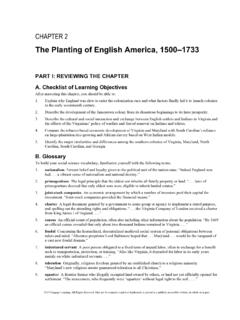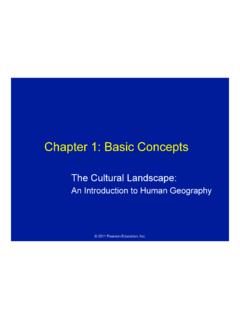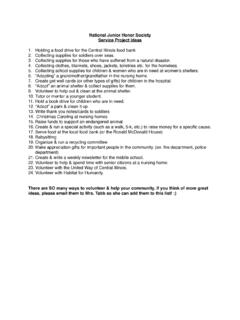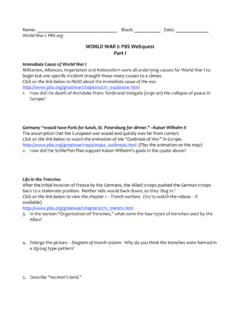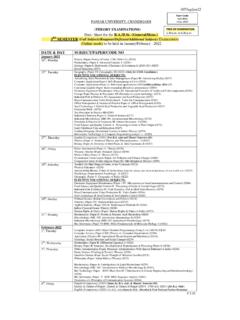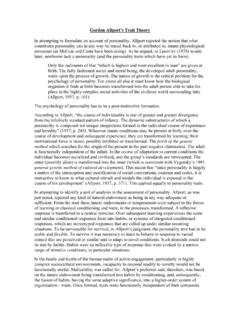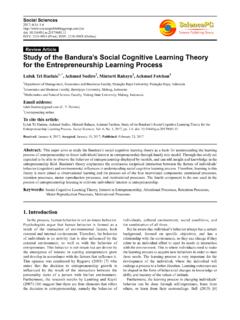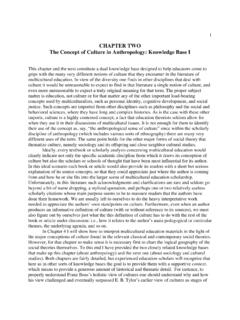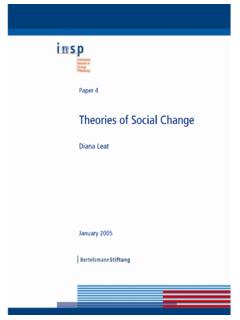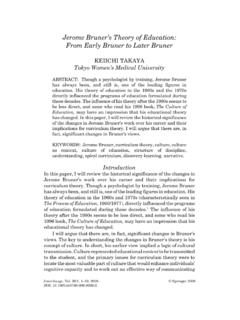Transcription of The Spread of Hellenistic Culture - Springfield Public Schools
1 146 Chapter 5 MAIN IDEAWHY IT MATTERS NOWTERMS & NAMESCULTURAL INTERACTIONH ellenistic Culture , a blend ofGreek and other influences,flourished throughout Greece,Egypt, and civilization todaycontinues to be influenced bydiverse cultures. Hellenistic Alexandria Euclid Archimedes Colossus ofRhodes5 SETTING THE STAGEA lexander s ambitions were cultural as well as militaryand political. During his wars of conquest, he actively sought to meld the conquered Culture with that of the Greeks. He started new cities as administra-tive centers and outposts of Greek Culture . These cities, from EgyptianAlexandria in the south to the Asian Alexandrias in the east, adopted many Greekpatterns and customs. After Alexander s death, trade, a shared Greek Culture , anda common language continued to link the cities together. But each region had itsown traditional ways of life, religion, and government that no ruler could affordto overlook.
2 Hellenistic Culture in AlexandriaAs a result of Alexander s policies, a vibrant new Culture emerged. Greek (alsoknown as Hellenic) Culture blended with Egyptian, Persian, and Indian influ-ences. This blending became known as Hellenisticculture. Koine (koy NAY),the popular spoken language used in Hellenistic cities, was the direct result ofcultural blending. The word koinecame from the Greek word for common. Thelanguage was a dialect of Greek. This language enabled educated people andtraders from diverse backgrounds to communicate in cities throughout theHellenistic and Cultural DiversityAmong the many cities of the Hellenistic world,the Egyptian city of Alexandriabecame the foremost center of commerce andHellenistic civilization. Alexandria occupied a strategic site on the western edgeof the Nile delta. Trade ships from all around the Mediterranean docked in itsspacious harbor.
3 Alexandria s thriving commerce enabled it to grow and the third century , Alexandria had become an international community,with a rich mixture of customs and traditions from Egypt and from the diverse population exceeded half a million s AttractionsBoth residents and visitors admired Alexandria s greatbeauty. Broad avenues lined with statues of Greek gods divided the city intoblocks. Rulers built magnificent royal palaces overlooking the harbor. A muchvisited tomb contained Alexander s elaborate glass coffin. Soaring more than350 feet over the harbor stood an enormous stone lighthouse called the lighthouse contained a polished bronze mirror that, at night, reflected theThe Spread of Hellenistic CultureCategorizingUse a chart to list Hellenistic achievements in various NOTESC ategory Achievementsastronomyaageometryphilosoph yartlight from a blazing fire.
4 Alexandria s greatest attractions were its famous museumand library. The museum was a temple dedicated to the Muses, the Greek god-desses of arts and sciences. It contained art galleries, a zoo, botanical gardens, andeven a dining hall. The museum was an institute of advanced study. The Alexandrian Library stood nearby. Its collection of half a million papyrusscrolls included many of the masterpieces of ancient literature. As the first trueresearch library in the world, it helped promote the work of a gifted group of schol-ars. These scholars greatly respected the earlier works of classical literature andlearning. They produced commentaries that explained these and TechnologyHellenistic scholars, particularly those in Alexandria, preserved Greek andEgyptian learning in the sciences. Until the scientific advances of the 16th and17th centuries, Alexandrian scholars provided most of the scientific knowledgeavailable to the s museum contained a small observatory in whichastronomers could study the planets and stars.
5 One astronomer, Aristarchus(AR ih STAHR kuhs) of Samos, reached two significant scientific conclusions. Inone, he estimated that the Sun was at least 300 times larger than Earth. Although hegreatly underestimated the Sun s true size, Aristarchus disproved the widely heldbelief that the Sun was smaller than Greece. In another conclusion, he proposed thatEarth and the other planets revolve around the Sun. Unfortunately for science, otherastronomers refused to support Aristarchus theory. In the second ,Alexandria s last renowned astronomer, Ptolemy, incorrectly placed Earth at the center of the solar system. Astronomers accepted this view for the next 14 (EHR uh TAHS thuh NEEZ), the director of the Alexandrian Library,tried to calculate Earth s true size. Using geometry, he computed Earth s circumfer-ence at between 28,000 and 29,000 miles. Modern measurements put the circumfer-ence at 24,860 miles.
6 As well as a highly regarded astronomer and mathematician,Eratosthenes also was a poet and and PhysicsIn their work, Eratosthenes and Aristarchus used ageometry text compiled by Euclid(YOO klihd). Euclid was a highly regardedClassical Greece147 VocabularyMuseummeans house of themuses. Greek AstronomyEratosthenes estimateof the circumference between 28,000 and 29,000 milesactual circumference 24,860 milescircumferenceEarthAristarchus estimate 300 times the size of EarthThe Sun is actually million times the size of 's view of the universeMercurySKILLBUILDER:Interpreting were Greek astronomers ideas most incorrect compared with modern concepts? estimate is closest to modern measurements? How could the Hellenists be soaccurate? Hipparchus, wholived in Alexandriafor a time, chartedthe position of 850 SunThe Solar System148 Chapter 5mathematician who taught in Alexandria. His best-known book, Elements,contained 465 carefully presented geometry propositions and proofs.
7 Euclid s workis still the basis for courses in important Hellenistic scientist, Archimedes(AHR kuh MEE deez) ofSyracuse, studied at Alexandria. He accurately estimated the value of pi ( ) theratio of the circumference of a circle to its diameter. In addition, Archimedesexplained the law of the in both geometry and physics, Archimedes also put his genius to practicaluse. He invented the Archimedes screw, a device that raised water from the ground,and the compound pulley to lift heavy objects. The writer Plutarch described howArchimedes demonstrated to an audience of curious onlookers how somethingheavy can be moved by a small force:PRIMARY SOURCEA rchimedes took a .. ship .. which had just been dragged up on land with greatlabor and many men; in this he placed her usual complement of men and cargo, andthen sitting at some distance, without any trouble, by gently pulling with his hand theend of a system of pulleys, he dragged it towards him with as smooth and even amotion as if it were passing over the ,Parallel Lives: MarcellusUsing Archimedes ideas, Hellenistic scientists later built a force pump, pneumaticmachines, and even a steam and ArtThe teachings of Plato and Aristotle continued to be very influential in Hellenistic phi-losophy.
8 In the third century , however, philosophers became concerned with howpeople should live their lives. Two major philosophies developed out of this and EpicureanismA Greek philosopher named Zeno (335 )founded the school of philosophy called Stoicism (STOH ih SIHZ uhm). Stoicsproposed that people should live virtuous lives in harmony with the will of god orthe natural laws that God established to run the universe. They also preached thatSummarizingWhat weresome of the mainachievements ofthe scientists of theHellenistic period?Arabic, 1250 Chinese, , TheoremGeometry students remember Pythagoras forhis theorem on the triangle, but its principleswere known earlier. This formula states thatthe square of a right triangle s hypotenuseequals the sum of the squared lengths of thetwo remaining sides. Chinese mathematiciansknew this theory perhaps as early as 1100 surveyors put it to practical use even earlier.
9 However, the work of the school thatPythagoras founded caught the interest of latermathematicians. Shown are Euclid s proof inGreek along with a Chinese and an Arabictranslation. The Arabs who conquered much ofAlexander s empire Spread Greek mathematicallearning to the West. The formula becameknown as the Pythagorean theorem throughoutthe Greece149 DrawingConclusionsWhat was themain concern ofthe Stoic andEpicurean schoolsof philosophy?TERMS & each term or name, write a sentence explaining its significance. Hellenistic Alexandria Euclid Archimedes Colossus of RhodesUSING YOUR Hellenistic achievement had the greatest impact? Why?MAIN did trade contribute tocultural diversity in theHellenistic city of Alexandria? did Euclid influence someof the developments inastronomy during theHellenistic period? did Stoicism andEpicureanism have incommon?SECTIONASSESSMENT5 CREATING A COLLAGEA rchimedes developed, or provided the ideas for, many practical devices the lever, forexample.
10 Consider some of the everyday implements that are related to these devices. Createa collageof pictures of these implements. Accompany each visual with a brief THINKING & WRITING6. SYNTHESIZINGD escribe how the growth of Alexander sempire Spread Greek INFERENCESWhat do you think was the greatestscientific advance of the Hellenistic period? Why?8. COMPARINGHow was the purpose served by architectureand sculpture in the Hellenistic period similar to the pur-pose served by these arts in the Golden Age of Athens?9. WRITING ACTIVITY The Hellenisticculture brought together Egyptian, Greek, Persian, andIndian influences. Write a brief essayshowing howAmerican Culture is a combination of different INTERACTIONCONNECT TO TODAYC ategory Achievementsastronomyaageometryphilosoph yarthuman desires, power, and wealth were dangerous distractions that should bechecked. Stoicism promoted social unity and encouraged its followers to focuson what they could (EHP uh KYUR uhs) founded the school of thought calledEpicureanism.
